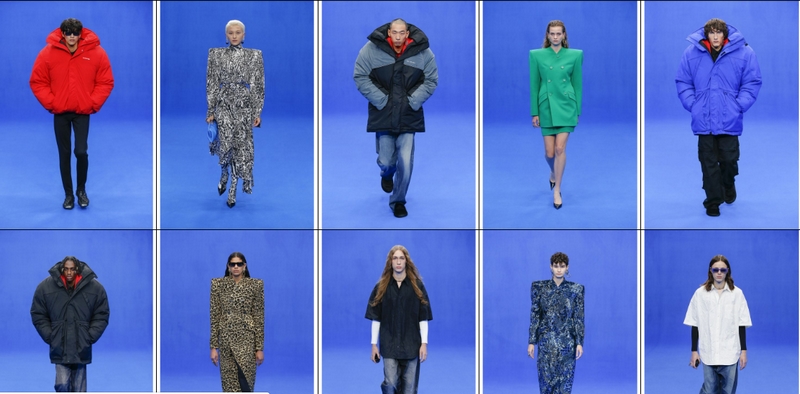There were many strange things about Balenciaga’s catwalk in Paris: the inflatable puffer jackets, which swelled high above the shoulders to give models the silhouette of Gru from Despicable Me; the lurid blue stage set inspired by the European parliament; credit cards worn as earrings.
Strangeness is what Balenciaga stands for under the designer Demna Gvasalia. There are traces of subtle meanings layered into what Gvasalia does – the visual joke of those inflatable jackets, for instance, is a reference to the cocoon shaped taffeta evening coats in which Cristóbal Balenciaga was dressing his clients 75 years ago – but weirdness is the overpowering top note.
A film studio in the Saint-Denis suburb of Paris was remodelled to resemble the European parliament in Strasbourg, with Euro-blue chairs arranged in an oval amphitheatre. Strip lighting blazed at maximum brightness, and the air conditioning was dialled to freezing – details seemingly designed to push the audience as far out of its comfort zone as possible.
The show opened with a silver-haired woman, credited in the show notes as “Neda Brady, an architect”, wearing a black trouser suit. The trousers were too big, held up by a basic-looking black belt, and too long, as if the wearer hadn’t got round to taking them up, so they bunched around her ankles. She wore her spectacles, but no makeup or any accessories beyond an office pass on a lanyard. A good look at her departing back view revealed that the jacket wasn’t merely oversized, but had a shoulder line exaggerated by internal boning.
Some of the clothes were shocking in their ordinariness. The palette might best be described as “commuter train”: dull black and grey studded with brash, Angela Merkel-brights. Men wore zippered nylon jackets with trousers, as if heading home from a shift. The casting mixed high-fashion favourites from past and present with ordinary people, so that “Tobias Mehlmann, a mechanical engineer” was followed by “Bella Hadid, a model”.
There was nothing ordinary about the vast bell-shaped ballgowns in crushed velvet or pleated lurex, which gave the models the larger-than-life silhouette. They looked a little like football mascots in padded costume, or Disneyland employees concealed inside Minnie Mouse, although Balenciaga fans will recall a loftier allusion, to devoted clients of the 1950s who travelled to balls by horsebox, such was the grand scale of their dresses and their determination not to ruin the silhouette.
The tone of audacious oddness made a strong statement, coming less than two weeks after Gvasalia announced he was stepping down from Vetements, the cult luxury streetwear label he founded with his brother, Gurum, four years ago.
Although both brothers have said the label will continue without Demna, his departure flags up that the heat around Vetements has been fading over the past year. It was the buzz around the label – with its DHL T-shirts, Kanye West in the front row and sold-out £1,000 jeans – that brought Gvasalia to the attention of the industry, winning him the plum job at Balenciaga. If fashion’s love of ironic-luxe streetwear fades, Balenciaga’s elevated take on that aesthetic will be called into question. Gvasalia is banking on his audience staying tuned to stranger things.
guardian.co.uk © Guardian News & Media Limited 2010
Published via the Guardian News Feed plugin for WordPress.


